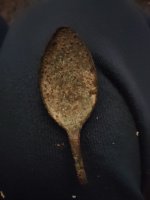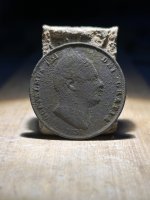Gypsy Heart
Gold Member
Chuctamunda Creek's Copper Teapot of Silver
An Address Delivered Before a Joint Meeting of the Mohawk Valley Historical Association and the Van Epps-Hartley Chapter, New York State Archeological Assn., 1936. (By Robert M. Hartley.)
Many brave men never came back from the field of Oriskany on that memorable August day in 1777. Some of the most prominent residents of Old Warrensburg died there and their bodies were never recovered or buried. Among them was Samuel Pettingill, a well to do farmer and country doctor, he was a man of education and influence and a captain in Col. Frederick Fisher's Third Tryon County Militia.
Family tradition is that on the morning of the day he marched with his company to join General Herkimer for the relief of Fort Stanwix, that having a considerable savings of silver money, which evidently he feared to leave during his supposed temporary absence he put this money in an old copper teapot of tea kettle, picked up a shovel and walked eastward from his house to the woods near the Chuctamunda creek where he buried his savings. His family had noted with interest all his preparations, but none accompanied him, merely noting the direction he had taken towards the creek, consequently were in ignorance of the exact spot he had chosen as a safe hiding place from theft and possible raiders. It is said he was gone a short half hour. That afternoon he marched away, and never returned. Many searches were made by the family for this buried money, but without results. Though the years that followed its burial, many friends and neighbors assisted in the search, but its hiding place was never discovered.
About thirty-five years ago two of Capt. Samuel Pettingill's great great grandsons, Dewitt and Milton Devendorf, enthusiastically renewed the search in which I and others assisted. During the early springtime we prodded over several acres with sharp pointed steel rods and many excavations were made where the rods indicated obstructions that did not feel like stones. However, the labor expended was no more successful than all previous searches. Captain Pettingill's hiding place of where he buried his money on that August morning, so long ago, perhaps will never be known.
The tradition of this buried treasure still lingers, for the ravine near where the money was supposed to be buried has been commonly known for a hundred years or more as "The Money Hole."
An Address Delivered Before a Joint Meeting of the Mohawk Valley Historical Association and the Van Epps-Hartley Chapter, New York State Archeological Assn., 1936. (By Robert M. Hartley.)
Many brave men never came back from the field of Oriskany on that memorable August day in 1777. Some of the most prominent residents of Old Warrensburg died there and their bodies were never recovered or buried. Among them was Samuel Pettingill, a well to do farmer and country doctor, he was a man of education and influence and a captain in Col. Frederick Fisher's Third Tryon County Militia.
Family tradition is that on the morning of the day he marched with his company to join General Herkimer for the relief of Fort Stanwix, that having a considerable savings of silver money, which evidently he feared to leave during his supposed temporary absence he put this money in an old copper teapot of tea kettle, picked up a shovel and walked eastward from his house to the woods near the Chuctamunda creek where he buried his savings. His family had noted with interest all his preparations, but none accompanied him, merely noting the direction he had taken towards the creek, consequently were in ignorance of the exact spot he had chosen as a safe hiding place from theft and possible raiders. It is said he was gone a short half hour. That afternoon he marched away, and never returned. Many searches were made by the family for this buried money, but without results. Though the years that followed its burial, many friends and neighbors assisted in the search, but its hiding place was never discovered.
About thirty-five years ago two of Capt. Samuel Pettingill's great great grandsons, Dewitt and Milton Devendorf, enthusiastically renewed the search in which I and others assisted. During the early springtime we prodded over several acres with sharp pointed steel rods and many excavations were made where the rods indicated obstructions that did not feel like stones. However, the labor expended was no more successful than all previous searches. Captain Pettingill's hiding place of where he buried his money on that August morning, so long ago, perhaps will never be known.
The tradition of this buried treasure still lingers, for the ravine near where the money was supposed to be buried has been commonly known for a hundred years or more as "The Money Hole."




